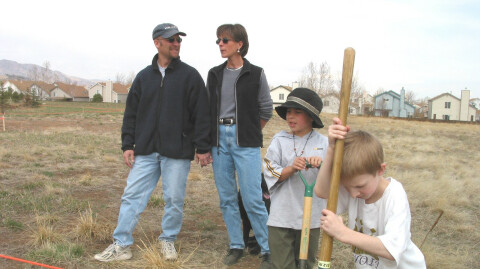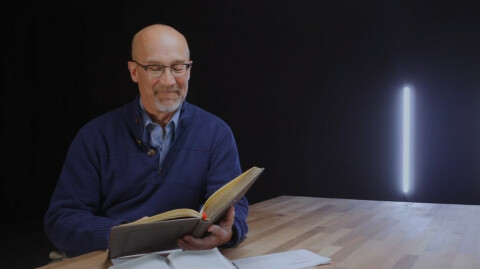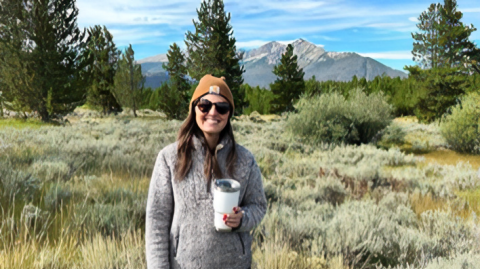
A classic anecdote relates the story of an anthropologist gathering origin stories from hunter-gatherer tribes. One elder says that the earth rests on the back of a giant turtle. “But what does the turtle rest on?” the anthropologist asks. “Oh,” says the elder, “it’s turtles all the way down.” The story evokes the image of a chain of turtles, with the smallest at the top and each turtle below a little bigger. Each turtle stands on another.
I thought it good to share a few Waterstone turtles with you, for we did not arrive here from nowhere. And where we have come from influences what we are doing in the present.
The Waterstone story can be told in two movements: Building and Refining
Movement One: Building - 1984 to 2003
In the spring of 1984, a small Baptist church on South Lowell Boulevard named Centennial Acres Baptist Church is on the verge of closing. They decide to reach out to a larger church (Bear Valley Baptist Church) for help. That summer, Bear Valley sends their student pastor Nick Lillo (he and Barb being in their late 20’s) and about 70 people to restart a church that would eventually be named Centennial Community Church. Yes, you are counting turtles correctly—Waterstone turns 40 this coming summer!
We learned much about flexibility and risk in those early years. With biblical preaching and a deeply committed elder group, the small church begins to grow. The vision is to relentlessly heed Jesus’ words, “Seek first the kingdom of God” (Matthew 6:33). In 1988, we merge with another small church named Covenant Baptist Church, located about a mile north on South Lowell Boulevard. That’s right, we meet in two different spaces a mile apart. The police officers who are behind on their quota of speeding tickets would sit on South Lowell waiting as parents “race” from the north facility worship to the south facility children’s ministry to pick up their kids. Because the seating capacity of the north facility is around 150 people, the challenge of holding many and multiple services in one facility while children’s programming happens in another begins to work against growth.
In 1991, the leadership team secures a rental agreement with both the Cooper 7 Movie Theater at Pierce and Coal Mine (now Front Range Christian School) and the Children’s World Day Care Center across the street from the theater. One favorite story is how we learn to anticipate God’s goodness every week. Because of their insurance liability, the movie theater could not give us a key to their building. Thus, we have to rely on the 19-year-old associate theater managers who drew the short straw to show up and let us in at 6am every Sunday to setup for worship. We never miss a Sunday in seven years. Christ is risen!
The church continues to grow to around 500 in attendance, and we are outgrowing what the theater can accommodate on a Sunday. In 1995, after a multi-year search, the church purchases the 26 acres we now inhabit at the corner of Bowles and Alkire for $400,000! There is quite a story behind the finding of this property that involves a U.S. President’s son and some bedrock, but that is beyond the space allowed here. Upon finding the acreage, the congregation pledges $1,385,000 towards a new building that is constructed over the next two years. In 1997, the church moves into that building—what is now the Activity Center and West Wing classrooms. What’s that old saying? “If you build it, they will come.” From this point, the growth of the church explodes. Over the next three years, Waterstone (still called Centennial) grows from 500 in weekend attendance to over 1,200 in attendance. It is a crazy-busy time as the church has to build systems, structures, and leadership to accommodate rapid growth while still discipling followers of Jesus.
It becomes quickly apparent that our first building phase does not have enough classrooms. After purchasing four temporary buildings in 2001 and still not having enough space, the elders make the decision to add on to our building—with what is now our Worship Center, Concourse, Hub and East Wing classrooms. The congregation raises over 3 million dollars over a three-year period toward this addition. The first service in the new Worship Center—sadly, a large funeral for a teen killed in a tragic car accident—happens in May of 2003.
Lessons and Continuing DNA:
Let me pause the story here to point out some of the turtles on which we stand.
First, our “mother church” Bear Valley had a heart for the city of Denver, starting all kinds of ministries in the city during the 1980s—Open Door Ministries, Inner-City Health Center, Mile Hi Ministries, Joshua Station. Waterstone has this same heart for loving our community deeply. We seek not only to proclaim God’s kingdom, but also to demonstrate it. Waterstone partners with and our people serve at 14 area ministries that seek to alleviate suffering, show mercy and advocate justice for the oppressed.
Second, during the first half of our existence, we demonstrate a willingness to risk trying new ways of ministry, new ideas for gathering spaces, and new ways to develop innovative leaders. Because of our proximity and partnership with Denver Seminary, we have developed over 70 leaders who now serve churches around the country and the globe.
Third, Waterstone is deeply committed to making disciples and is known as a place to grow deeper in faith. This explains our commitment to biblical preaching and eucharismatic worship. Our worship seeks to both encounter God in expressive and emotive connection as well as to be formed by God through liturgy and the public reading of Scripture. As well, we emphasize discipleship through opportunities like Wednesdays at Waterstone, our Leadership program, our podcast, and our Justice in Action course. We provide discipleship-oriented kids and youth ministries, and we encourage radical generosity toward our extensive global and local partnerships.
Movement Two: Refining – 2004 to 2023
Not long after settling into the new building, we begin to get calls asking, “Which side of I-25 are you?” This is because of the growth of the city of Centennial. Therefore, in 2006 we changed our name from Centennial Community Church to Waterstone Community Church. “Waterstone” is a stone used for sharpening. We desire that everyone who is part of Waterstone for any length of time experience transformation.
From 2006 to 2010, Waterstone engages a process of refining our mission and vision. We settle into a vision statement and discipleship methodology (our three Rhythms: Transform, Neighbor and Restore) that is explicit about our commitment to the Kingdom of God. We strive to attach everything we do at Waterstone to our mission and three rhythms. Our mission is...
To be a people empowered by the presence of Jesus Christ to proclaim his kingdom and demonstrate his love, justice and mercy to our neighbor.
As we like to capture it: we want to become like Jesus and live for others.
Our vision over the last two decades has been to grow into a church of a thousand and then plant churches. Waterstone has planted six churches, two of which are still going strong today (The Bridge at Bear Creek and Resilience). We have also continued our emphasis on developing leadership, especially over the last decade as many of our current pastoral staff have come from within our congregation. In 2019, we walked through our first Lead Pastor transition from Nick Lillo to Larry Renoe.
Waterstone believes that one of the greatest assets we have for loving our community is our beautiful, spacious facility. We said at our first service in our 1997 building, “We are building this building to wear it out for God’s kingdom.” Then Nick proceeded to spill a cup of Kool-Aid on the brand new rug to “christen” the brick and mortar. Our building is used for all kinds meetings most every day of the year—from girl/boy scouts to charter schools to preschool to Zumba groups to Civil Air Patrol to Community Bible Study. Waterstone is a place of action and welcome in the name of Jesus.
At the same time, our building has not caused us to become inward focused. Our partnerships with Jefferson County and local non-profits have grown deep and wide over the last two decades. Our staff and volunteers collaborate with Jefferson County Human Services and Sherriff’s Department on initiatives that have served the common good of our community.
Lastly, Waterstone has become a “neighboring” church. The reason our church and every Christian church exists is because God loves the world, and he wants them to know it. Thus, the primary calling is to love our neighbor. At Waterstone, neighboring means praying for our neighbors (those with whom we live, work and play) by name each week. It means engaging our neighbors in conversation as often as possible because life unfolds one conversation at a time, and conversations tend to progress from surface to serious to spiritual. And neighboring means welcoming our neighbors to our tables—at home and at church to see and experience the presence of Jesus.
“It’s turtles all the way down.” We stand on the shoulders of many, but especially and above all—the shoulders of a homeless Man named Jesus. He owns the world, loves the world, and has rescued us all.



